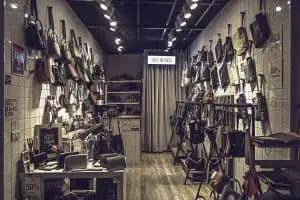Introduction
These days, it’s all about conversion. The more we are able to attract our audience and get them to buy our products, the more profit we will generate. In digital marketing, this can be easily accomplished through online advertising. Advertisers plant copy that hopefully triggers an action or reaction in the consumer’s mind.
In this post, we are going to delve a little deeper into this matter to see how brands can ignite action (and purchase) by developing non-cognitive behaviour. In simple terms, thinking is an obstacle to doing and investing in creating non-rational patters in the minds of our target audience has, in time, a profound impact on our conversion rates.
This is not rocket science, as we all experience it, almost on a daily level. Seeing a queue in front of a shop, not being able to book a restaurant, hearing again and again about a movie or a book. In all of these cases, our own perceptions – or even tastes – are overdriven by our senses.
A successful business will always attract new customers but in this post, we’re going to discuss how this does not have to happen only because of chance, but also because of design.
In this post we’re going to discuss:
- Doing is easier than thinking: the formula to doing and not thinking
- Understanding and leveraging customer motivation
- Use a technological shortcut with efficiency innovation
- Conclusions
1. Doing is easier than thinking: the formula to doing and not thinking
To some extent, we can consider the following principle: the more effort an action requires, the less likely it is to occur. As discussed in the book Hooked: How To Build Habit-Forming Products, we can use a scientific approach to measure behaviour which can be summarised in a simple formula: B= MAT.
According to this formula, Behaviour is a result of consumer’s Motivation, the ability to perform an Action and the presence of a Trigger. A brand, especially in the context of fashion, where our own emotional impulses are a great tool to overcome premium pricing, should take into account these three factors in order to boost conversion rates. Let’s look into each more closely.
- Motivation. Motivation relies on the objective the consumer seeks through the purchase. The stronger the motivation, the higher to likelihood to overcome hinderance to act.
- Action. Action is the actual engagement or conversion of a lead into a customer. A conversion relies heavily on ease of use. This is why organisations need to become more and more customer-centred. Both in the digital and physical space fashion firms need to simplify and make more efficient the customer’s journey in order to enhance chances of conversion.
- Trigger. The trigger is the Pavlovian element of behaviour, the element which stimulates a certain behaviour. Simple examples of this are represented by limited-time offers like Black Fridays. The perception of urgency is a strong trigger for purchase behaviour and it often overrides our rational behaviour.
All of these three elements need to carefully weighted in order to influence consumer behaviour and optimise conversion. As we’ve discussed in a previous post: Building a Habit is the New Branding reaching out and leveraging your audience’s fashion addictions is a very effective way to retain customers and increase customer lifetime value. If on the one hand Triggers and Actions can be addressed by technical optimisations, on the other hand, the dynamics of motivations are not easy to grasp. We’ll address this topic in the next section of the post.
2. Understanding and leveraging customer motivation
Motivation relies on the fundamental pursuit of pleasure. In this sense, we buy what we buy to escape pain and pursue gratification, to escape fear and pursue hope, to escape rejection and pursue acceptance. As discussed in the video by Dan Pink, we can see that even for what may seem the most obvious situations, the motivations which can actually ignite action are not as obvious as they may seem.
Moreover, motivation can be easily connected to rewards, or in the words of Nir Eyal, ‘variable reward’. According to his book, Hooked: How to Build Habit-Forming Products. The variable nature of a reward adds a gamification aspect to the purchase process. If every time we played a game we’d end up always achieving the same outcome, we would never build up the enthusiasm to play a game again and again.
According to literature, there are therefore three categories of rewards:
- Tribal Rewards. Tribal rewards relate to the reward perceived by a shopper when heshe feels that the benefit of a purchase is a social reward, in terms of feeling accepted into a community.
- Hunter Rewards. These rewards tap into something more instinctual, which relate to the pleasure of pursuing physical objects. This may also relate to shopping for goods which pertain to our primary needs for survival.
- Self Rewards. These rewards escape categorisation as they relate to an intrinsic motivation which is different for all of us.
In all of these types of reward, one thing is common to all. The emotional feedback is intensified by the rush for the pursuit of pleasure, so in a certain sense, giving users what they want does not increase repetition, it is not habit-building.
3. Use a technological shortcut with efficiency innovation
A firm at this stage can decide to act upon the B=MAT principle by approaching three distinct elements.
- For the motivational element, and for the trigger element a better understanding of human behaviour and ‘job to be done’ is a viable approach. We discuss this topic in greater depth in this article: Why Jobs to Be Done Matters for Your Business.
- For the Action element instead, a different approach can be pursued. In this context, we need our firm to be innovative and designed a more efficient way to shorten the customer journey.
This latter element can be analysed according to two separate perspectives: on one level, a company can redesign its business model in order to deliver more value at a lower cost, or simplify (by speeding up) the purchase process, or amplify the audience able to purchase a particular product. All of these types of strategies actually relate to 4 distinct types of innovation which we discuss in more detail in this post.
Looking at efficiency in more detail we can add that most times what a fashion firm can do is focus on the customer experience and design workflows, processes and interface designs which make shopping effortless. This opens a whole new Pandora’s box, which we are discussing in more detail in a post entitled: Use Mobile UX Design to Grow Your Business.
Let’s now wrap things up in the conclusions section of the post.
4. Conclusions
In a time in which customer engagement is everything, fashion brands need to find new ways to solve the ‘puzzle of motivation’ in order to create compelling value propositions to their customers. As we’ve seen in this post, creating a communication strategy capable of taking into account Motivations, Actions and Triggers is a challenge which can potentially turn a business upside down. All in all, nowadays, in an over-inflated market, firms really need to delve deep into customer behaviour, not only to deliver something persuasive but to really understand how they can help their customer getting their jobs done.
If you’re interested in learning more about the Fashion Industry, don’t hesitate to take a look at our course “The Fashion Industry: Explained”. Our in-depth class covers a wide range of topics spanning from understanding fashion customers and markets to developing immersive retail experiences for your customers. Here’s a link to the course, if you use the discount code BLOG20 you can access a 20% discount. Enjoy!







